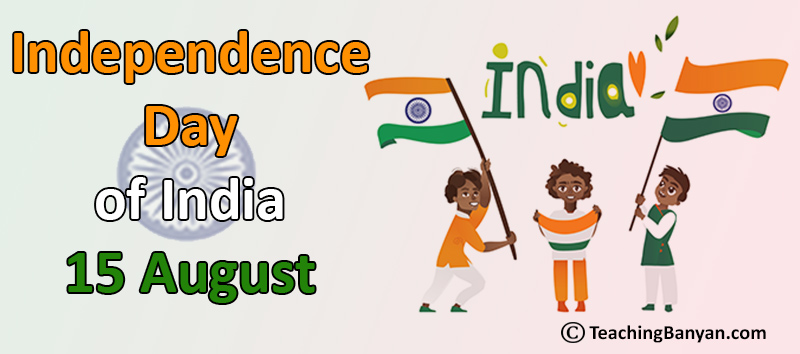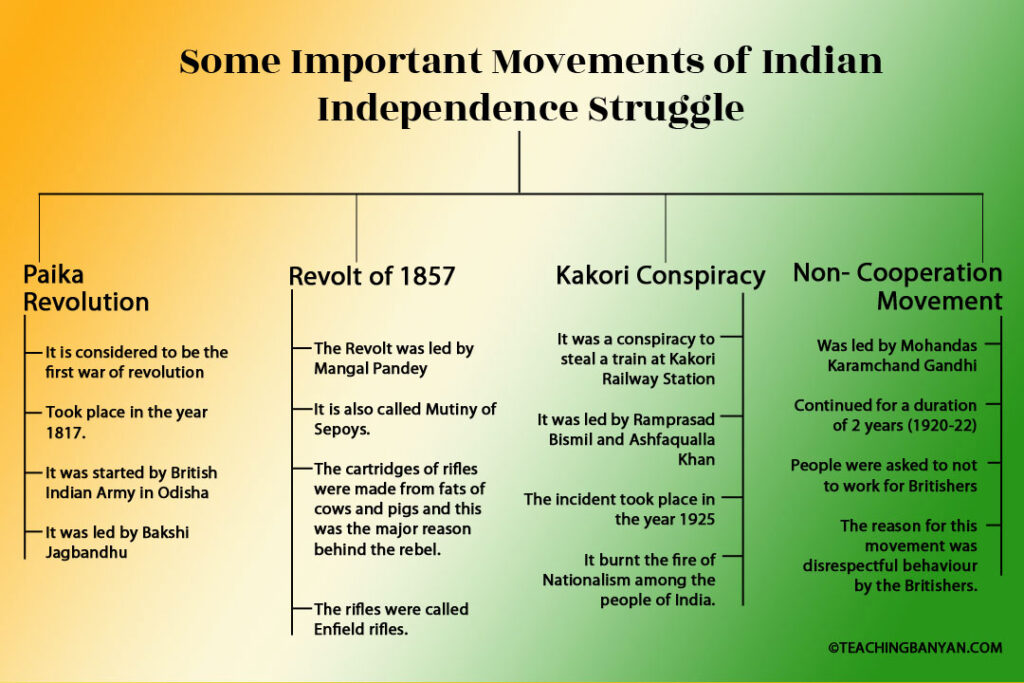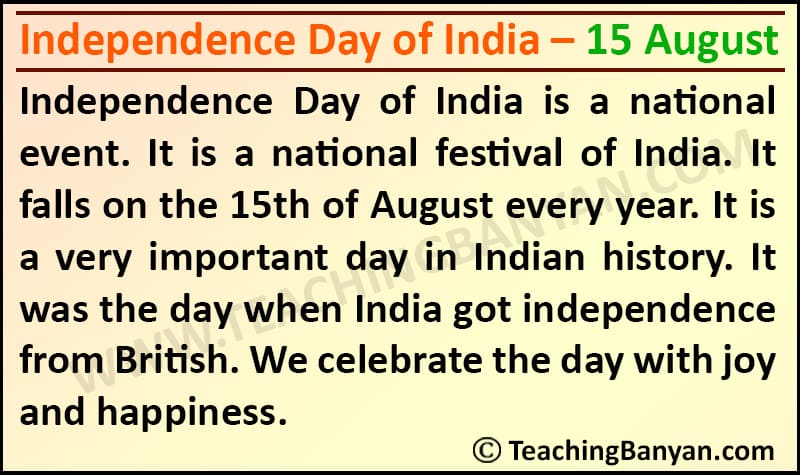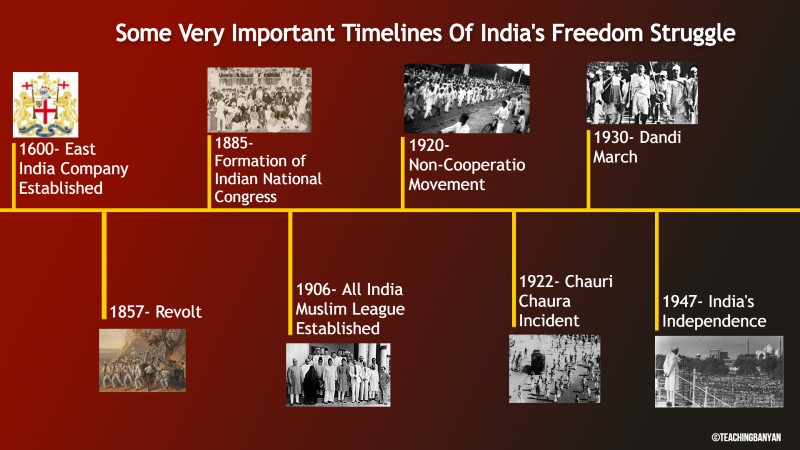
Independence is of immense significance for a country, as it signifies freedom and self-rule. It enables a country to make its own decisions, shape its own destiny, and work towards the progress and development of its people. It allows a nation to establish its own political, social, and economic systems according to the needs and aspirations of its citizens. In India, Independence Day is celebrated on the 15th of August every year, reminding us of the day when India gained its freedom from British rule in 1947. It is a day to remember and honor the leaders who fought hard for our rights and the people who worked together to get rid of the Britishers.
What is special on this 77th Independence Day 15 August 2023
Since, the Independence Day of India is celebrated every year, we will celebrate its 77th anniversary of freedom on 15 August 2023, Tuesday of the week.
As part of the “Azadi ka Amrit Mohatsav” celebrations, Independence Day 2023 will have the theme “Nation First, Always First”. As part of this effort, the government has committed to carrying out a variety of projects that will honour the different cultures that exist within the country. The campaign’s objective is that by coordinating its activities and reaching out to people in India and around the world, they can give this people’s movement an even greater boost. Independence Day of this year will also mark the completion of Amrit Mahtosav’s 75-week countdown, which started on March 12, 2021 and will end on this year’s Independence Day.
India will celebrate its 77th Independence Day with a special program called “Meri Mati, Mera Desh.” This campaign will pay tribute to the brave soldiers who died for the country. It will take place from August 9 to August 30 and will include events at national, state, village, and local levels. As part of the campaign, there will be an “Amrit Kalash Yatra,” in which soil from different parts of the country will be brought to Delhi and used to make an “Amrit Vatika” near the National War Memorial. This ‘Amrit Vatika’ will also serve as a magnificent representation of ‘Ek Bharat Shrestha Bharat’. The project will include activities such as the installation of commemorative plaques dedicated to freedom fighters and security forces, as well as initiatives like Panch Pran Pledge, Vasudha Vandan, Veeron ka Vandan, etc which pays tribute to the courageous sacrifices of our heroes. The campaign will also include activities such as planting trees, writing slogans, and organizing cultural programs in schools to promote patriotism and love for the country among students.
India’s freedom is one of the most important events in history. It was the end of a long, hard fight against colonial rule. It is a story about how the Indian people fought for their rights, culture, and identity while living under harsh British rule. In the history of our country, Independence Day is known as the Red-Letter Day. It was a hard and long fight, and many freedom fighters and great men gave their lives for our beloved country. In simple terms, it’s a journey into the spirit of resistance, unity, and sacrifice that led to India’s freedom and its emergence as a sovereign country.
How Independence Day is celebrated?
The Independence Day is a public holiday in India. The celebration begins with the hoisting of the national flag at the Red Fort in New Delhi by the honorable Prime Minister of the nation. The tricolor flag, representing peace, unity, and courage, proudly flutters in the sky while the national anthem echoes through the air, instilling a sense of patriotism among the people. To mark this holiday, sports and culture competitions are held, and the winners are given prizes. Everywhere one can hear patriotic songs. The television channels show movies and documentaries with patriotic themes to teach people and children about the strug for freedom.
The entire country is adorned in the hues of saffron, white, and green, symbolizing bravery, peace, and fertility respectively. Citizens, irrespective of their age, religion, or social background, participate in the festivities with immense joy and enthusiasm. Schools, colleges, government institutions, and residential colonies organize various cultural programs, parades, and flag-hoisting ceremonies to express their love for the nation. People also wear traditional attire, sing patriotic songs, and indulge in traditional Indian delicacies. Kites, representing the soaring spirit of freedom, fill the sky as families engage in kite-flying competitions.
Significance of Independence Day
Independence Day, celebrated in India on the 15th of August each year, holds great importance for every Indian citizen. This auspicious day commemorates India’s freedom from the British rule and the subsequent birth of the largest democracy in the world. The day serves as a reminder of the sacrifices made by great leaders who fought tirelessly for India’s independence. Independence Day is a day of great pride and unity, as it brings the entire nation together in celebrating the invaluable gift of freedom and honoring those who stood against oppression, dedicating their lives to achieve a sovereign India.
The fight for freedom that our people have been through shows us that the freedom we enjoy today was bought with the blood of hundreds of people. It makes every Indian proud to be an Indian. It helps the current generation learn about the freedom heroes of India and understand the struggles of the people around them. Independence Day holds great significance in India as it marks the country’s liberation from British colonial rule and the establishment of an independent nation. Moreover, it is a day of patriotic fervor, where citizens come together to honor their freedom, express their love for the nation, and pay homage to the leaders who played an instrumental role in shaping the destiny of India.
Colonial Rule: India’s Past under British Control
India was ruled by the British Raj for a long time. India was run by the East India Company for about 100 years. After winning 1757’s battle of Plassey, British took over the Indians and ruled our country. For about 200 years, the British ruled over India. Every Indian’s life was miserable and hard when they were ruled by the British. Indians were treated like slaves and were unable to express what they wanted. The British officers controlled the Indian masters like puppets. In British camps, Indian soldiers were treated cruelly, and farmers were starving because they couldn’t grow crops and had to pay high land taxes. The conditions of Indians under British rule were pathetic.
Voices of Rebellion: Famous Freedom Fighters in India’s Fight for Independence
India wouldn’t have been able to become independent without the work of many brave freedom fighters. Some of the well-known names are Chandra Shekhar Azad, Bhagat Singh, Subhas Chandra Bose, Ram Prasad Bismil, Ashfaqulla Khan, Mangal Pandey, Udham Singh, Mohandas Karamchand Gandhi, Jawaharlal Nehru and many more. Apart from men, during the Indian freedom struggle many women also played important roles. Savitribai Phule, Mahadevi Verma, Capt. Laxmi Sehgal, Rani Laxmibai, and Basanti Devi are just a few vital names to remember. There are many unsung heroes who played an important role in getting India to be independent.
Celebrating India’s Independence Day: Commemorating the Struggle for Freedom
At the stroke of midnight on this day, our first Prime Minister, Pandit Jawaharlal Nehru, raised the National Flag for the first time at the Red Fort. It was the end of the British rule in India, which had lasted for 200 years. We now live in a country that is free and has its own government. India got its freedom on August 15, 1947, at midnight. Jawaharlal Nehru, our first Prime Minister, gave a beautiful speech that began, “At the stroke of midnight, when the world sleeps, India will wake up to life and freedom.” However, this freedom came at a great cost—the partition of India. The country was divided into two separate nations, India and Pakistan, leading to widespread violence, mass migration, and the loss of countless lives. Nevertheless, on August 15, 1947, India finally gained its freedom after centuries of foreign rule. India became independent, but when it did, it was split into two countries: India and Pakistan. Pakistan’s Independence Day is on August 14th instead of August 15th.
Movements associated with India’s Independence

Indian National Movement helped bring together a number varying types of people and social groups into one country. This helped shape an important time in Indian history. There were a lot of different ways that the country was set free. The goal of the Indian independence movement, which was a set of historical events, was to end British rule in India, which was called the British Raj. It lasted from the years 1857 all the way up until 1947.
Revolt of 1857
The first war of independence against the British was the Revolt of 1857. On May 10, 1857, the revolt started in Meerut. Slowly, people in Delhi, Agra, Kanpur, and Lucknow joined in. It was the first step in the fight against the British and the first drive for Indian independence, but it didn’t work. The 1857 revolt failed because local people didn’t join and there was no central leadership. Many Indian kings, like the Maharaja of Kashmir and Holkar of Indore Sindhia of Gwalior, also didn’t join. This uprising led to the end of the East India Company’s rule in India, and in 1858, the British Crown took over the Company’s powers. From here, a series of nationalist movements in India started, which led to big freedom movements in India.
Swadeshi Movement
The Swadeshi Movement was a social and political movement that started in Kolkata, India, at the beginning of the 20th century. Lord Curzon’s news that Bengal would be split up led to the start of the Swadeshi Movement. At a meeting in the Calcutta Town Hall on August 7, 1905, the Boycott motion was passed. The goal of the Swadeshi movement was to get people to use Indian goods and services instead of British ones. This made India’s economy better and sent the British a clear word that Indians can live on their own.
Ghadar Movement
The Ghadar Movement transformed Indian freedom movements. In the 1900s, Punjabis came to North America, particularly Canada and the US, to work in fields and industries. The Pacific Coast Hindustan Association (Ghadar Party) emerged from this idea. In the early 20th century, Canada passed various racially discriminatory immigration rules to reduce the number of Indian immigrants seeking work. During a fight with British cops, the passengers were killed. British cruelty prompted the Ghadar Movement.
Home Rule Movement
The Home Rule Movement was the country’s reaction to the First World War. Bal Gangadhar Tilak started the Home Rule Movement in Belgium in April 1916. Pune and Madras were the places where the movement began. In September 1916, Annie Besant joined the movement in the city of Madras. The goal of this movement was to get rid of the British Government so that the British could run their own affairs.
Champaran Movement
The Champaran Satyagraha was a movement of civil resistance. In 1917, Mahatma Gandhi led it in the Champaran area of the Indian state of Bihar. The Tinkathiya System makes farmers or cultivators grow indigo on the best 3/20th of their land and sell it for less than it’s worth. Mahatma Gandhi went to Champaran and started this civil disobedience campaign. He went on strikes and held protests in Champaran against the owners.
Rowlatt Movement
The British Indian government passed the Rowlatt Act of 1919. The Anarchical and Revolutionary Crimes Act was another name for it. The Act gave the government the power to put people in jail for up to two years without a hearing if they were accused of crime. The Rowlatt Act took away some of the rights of the press. On April 6, 1919, Mahatma Gandhi began a peaceful strike called Rowlatt Satyagraha against the Rowlatt Act, which was passed by the British government.
Khilafat Movement
The Ali brothers came up with the idea for the Khilafat Movement that took place between 1919 and 1924. The way the British took down the Caliph in Turkey did not make the Indian Muslims happy. Mahatma Gandhi started the protest movement against British rule. The movement wanted to bring back the Caliph, who was losing power in Turkey.
The Salt March or Civil Disobedience Movement
The Civil Disobedience Movement began in 1930 with Mahatma Gandhi. It is thought to have helped India become free. On March 12, 1930, the Dandi March was the first step in the revolution. Gandhiji and 78 other people walked from Sabarmati Ashram to Dandi to break the salt law. The movement spread all over the country, and over 60,000 people including Mahatma Gandhi, was jailed.
Individual Satyagraha
The leaders of the Indian National Congress (INC) didn’t like how the British government dragged India into the second World War without asking the Indian people first. Mahatma Gandhi began the Individual Satyagraha when the INC asked for full freedom from colonial rule.
Quit India Movement
The Quit India Movement, also called the Bharat Chhodo Andolan, was started by Mahatma Gandhi on August 9, 1942, at a meeting of the All India Congress Committee in Bombay. All of the Indian freedom fighters stated that they would not obey the British government in any way. The goal of the movement was to get the British out of India.
Conclusion
Independence Day is an occasion for all Indians to express their patriotism and gratitude towards our motherland for providing us the opportunity to live in a free and independent nation. India’s journey to independence was a sign of how strong its people were. They fought against British rule and set up a free country. People like Mahatma Gandhi continue to be an inspiration to new generations because of the sacrifices they made and the way they led. India’s battle against colonialism is a reminder that the fight for freedom, justice, and equality is a struggle that goes beyond boundaries and time. The future of our country is now in the hands of India’s young people. We should understand its importance and work towards making our nation the best.
Some Interesting Facts related to Independence Day of India
- 5 Countries including Bahrain, Republic of Congo, Liechtensteine, North Korea and South Korea got
independence on 15 th August. - India’s national flag was designed by Pengali Venkaiyaah.
- Pakistan got early independence as Lord Mountbatten was supposed to be present in both country’s independence
ceremony. - On the day of Independence, freedom fighter Sucheta Kriplani sang Vande Mataram in the
parliament. - Mahatma Gandhi didn’t join the Independence Day celebrations as he was in Calcutta to turn down the riots going on between Hindus and Muslims.
Know More Facts about National Flag of India….

Timeline of Freedom Struggle of India
During the around 200 years of freedom struggle, India has gone through many movements, revolts, and many other historical changes. These are worth to be read, and we have provided a timeline based on it below:
- 1600 – East India Company was established in India on 31 December.
- 1817 – Paika Rebellion was organized by the British Indian Army in Odisha.
- 1857 – The famous Revolt of 1857 led by Mangal Pandey and started on 10 May from Meerut.
- 1864 – Scientific Society was established by Sir Syed Ahmed Khan.
- 1878 – Freedom of Press was assured through the ‘Vernacular Press Act’, proposed by then viceroy Lord Lytton.
- 1882 – Hunter Commission (Indian Education Commission) was established for the growth of education in India.
- 1883 – Lord Ripon proposed the Ilbert Bill.
- 1884 – Ilbert Bill was passed by the then Government of India.
- 1885 – Indian National Congress was founded at Bombay in India.
- 1897 – Swami Vivekanand founded Ram-Krishna Mission.
- 1905 – Lord Curzon announced the Partition of Bengal in July, and it took place in October.
- 1906 – All India Muslim League was founded at Dhaka.
- 1907 – Surat split of Indian National Congress.
- 1908 – Khudiram Bose was executed on the 11th of August.
- 1909 – The famous ‘Minto-Morley Reform (Indian Council Act)’ took place.
- 1910 – ‘Indian Press Act’ was promulgated by the British Government.
- 1911 – The Partition of Bengal was canceled.
- 1912 –Rashbehari Bose and SachindraSanyal threw a bomb on Lord Hardinge, Delhi became the capital of India.
- 1913 – ‘Ghadar Party’ was formed.
- 1914 – ‘First World War’ started on 28 July.
- 1915 – Mahatma Gandhi returned from South Africa.
- 1916 – Bal GangadharTilak established ‘Home Rule’ in April.
- 1916 – ‘Lucknow Pact’ between Indian National Congress and Muslim League took place in December.
- 1917 – Champaran Satyagraha was started by Mahatma Gandhi.
- 1918 – ‘Madras Labour Union’ was established.
- 1919 – ‘Montagu Chelmsford Reform’ took place, ‘Rowlett Act’ was passed and the brutal ‘JallianwalaBagh Massacre’ happened.
- 1920 –‘Non-Cooperation Movement’ started.
- 1922 – ‘Chauri-Chaura Incident’ took place.
- 1923 – ‘Swaraj Party’ was established.
- 1925 – ‘Kakori Conspiracy’ took place.
- 1927 – ‘Simon Commission’ was established.
- 1928 – Bhagat Singh and Rajguru assassinated Saunders, and ‘Simon Commission’ reached India in February.
- 1929 – Bhagat Singh and BatukeshwarDutt bombed in Central Legislative Assembly, and ‘Purna Swaraj’ was declared in Lahore on 31 December.
- 1930 –‘Civil Disobedience Movement’ and Dandi March’ started, ‘Chittagong Armoury Raid’took place and ‘First Round Table Conference’ happened.
- 1931 – ‘Bhagat Singh was Hanged with Rajguru and Sukhdev’, ‘Gandhi Irwin Pact’ on 5 March and 2nd Round Table Conference.
- 1932 – 3rd Round Table Conference and Poona Pact.
- 1935 – ‘Government of India Act’ took place.
- 1937 – Under the Act of 1935, elections took place in India.
- 1938 – Subhash Chandra Bose became the president of Congress.
- 1939 – ‘Second World War’ started on 1 September.
- 1941 – Rabindranath Tagore died on 7 August.
- 1942 – ‘Quit India Act’ took place and ‘Azad Hind Fauj’ was formed.
- 1945 – ‘Shimla Conference’ by Wavell to form the executive council of Indian leaders.
- 1946 – Royal Indian Air-Force Mutiny.
- 1947 – India became an independent nation on the 15th of August.

FAQs: Frequently Asked Questions
Ans. 77th Independence Day will be celebrated in India in 2023.
Ans. Our flag is hoisted at Red Fort on Independence Day.
Ans. Sachindra Prasad Bose hoisted the flag for the first time.
Ans. The specialty of Independence Day is the ending of British rule and the establishment of freedom of India.
